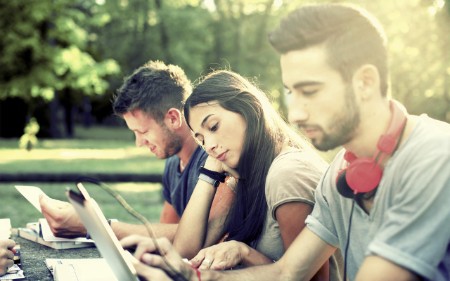
Chapter 1
Identifying a purpose disconnect
Employees sense a gap between what leaders say and what the business actually does.
What exactly is purpose, and why does it matter? At its most basic level, purpose is an articulation of why a company does what it does, and for whom it creates value. In the words of one multinational C-suite executive we spoke to, “The point of a purpose is to make it clear to everybody who is in a company or institution why they exist and what shared journey they’re on.”
At EY Beacon Institute, we define Purposeful companies as those that go beyond shareholder profits to encompass a purpose that serves employees, customers and society as a whole (purpose with a “capital P”). Purposeful companies successfully drive their purpose into their organizations and recognize the importance of truly engaging their employees on the firm’s purpose journey. Our research shows that these companies are better at attracting talent, spurring innovation, navigating disruption and yes, making a profit – all key for surviving and thriving in today’s volatile world. You might even call this “enlightened self-interest.”
Yet as EY Global Chairman and CEO Mark Weinberger observed at a recent event with EY Beacon, “while many leading organizations understand the power of purpose, they find that integrating purpose into their strategy and realizing its full value is much more challenging.” Indeed, building an organization that truly lives its purpose takes more than just leadership at the top level – it takes living it at every level. And it’s becoming clear that employees are not experiencing the sense of purpose that many of their bosses claim to be pursuing.
For example, research by EY and Forbes Insight found that the more senior an executive, the more confident he or she is of both articulation and activation of purpose within their firm. Ninety-eight percent of CEOs surveyed agreed with the statement that “our purpose is central to our organization and is well understood by all.” But this confidence progressively weakened at each lower level of management, falling to 50 percent among vice presidents. A similar pattern held when respondents were asked how well purpose determined their firm’s strategy and decision-making.


For our recent How can purpose reveal a path through disruption? study, we surveyed nearly 1,500 senior executives and business leaders from around the world. This was balanced by parallel research done with lower- and middle-level employees. Comparing the results was telling: executives significantly overrated how well their employees experienced their firm’s purpose. Furthermore, we also found that more than one-third of employees (35%) observed a disconnect between their organization’s stated purpose and its day-to-day actions.

This “say-do” gap between promise and experience is dangerous. It disenfranchises employees and harms morale. It undermines an organization’s reputation among its customers and other stakeholders, who will not hesitate to call out perceived hypocrisy on social media and other platforms. And it prevents firms from realizing key benefits of being guided by purpose, from sparking innovation to navigating massive disruption, that are critical for competing in today’s volatile global economy.

Chapter 2
Sources of the purpose disconnect
Poor communication and misaligned incentives.
We've identified two primary sources of this purpose disconnect between leaders and employees.
1. Poor communication
Many workers believe their organization’s broader purpose hasn’t been properly explained to them. Comparing results from our parallel surveys of executives and less senior employees, for example, showed that far fewer employees believed that their organization had a purpose focused on multiple stakeholders (“capital P Purpose”) than did senior executives. Workers were much more likely to state that their company’s purpose was purely to create value for customers – something those on the front lines were more used to hearing.
In other words, many employees still think of their jobs in terms of immediate tasks rather than the larger, aspirational purpose for which executives claim the organization exists. In these cases, business leaders have failed to convey how the broader purpose relates to the work of the employees, resulting in an absence of resonance and buy-in.
2. Misaligned incentives
Even in organizations in which purpose is well understood and embraced, many leaders have failed to empower their employees to act on it. The research behind How can purpose reveal a path through disruption? found that 37% of employees think their performance isn’t linked to their organization’s purpose.
Misaligned incentives
3/10Nearly three in 10 employees say that salaries and remuneration incentives are not connected to their firm's stated purpose.
As a result of these findings, it's possible to infer that one in three employees is walking the halls of their company questioning whether the time they spend at work actually means anything.
In these cases, employees aren’t necessarily wrong to think their organization’s aspirational purpose is just that – an aspiration – and not relevant to their day-to-day experience. That’s because the metrics by which their performance is measured do not align with the metrics by which the firm’s purpose is measured. When employees feel like their company’s purpose is just a slogan on the wall, they are less likely to go the extra mile on behalf of their employer and more likely to look for a job elsewhere. That’s not a recipe for success in a competitive world.

Chapter 3
Closing the “say-do” gap
Consistent messaging, empowerment and measurement.
Companies have to attack the “say-do” gap from multiple angles if they’re truly determined to reap the benefits of purpose-driven business. Looking at examples from companies who are progressing on their purpose journeys, we can identify three key practices to bridge the purpose disconnect between executives and employees.
1. Reinforce the message
Leading companies clearly articulate why their firm exists. What do they stand for? What makes it worth their employees giving their time – the most valuable asset they have? Rather than stopping there, businesses that live their purpose drive that message home by demonstrating how it is connected to what the business actually does commercially. Are its strategies supporting its purpose? Or is it just growth for the sake of growth, profits for the sake of profits?
If a purpose is truly to take hold, it needs to be repeated and reinforced continuously by leaders at all levels of the organization. The CEO of a large professional services firm told us he talks about the company’s purpose in every speech he gives. “I give town halls around the world,” he said, “and I always talk about our purpose and our values as the fundamentals for what our business strategy is.” It is no surprise, then, that a key principle for this person is the need to “communicate, communicate, communicate,” and to provide “a link between what [employees] do every day and the purpose the organization serves.”
2. Empower employees
Top-performing companies empower their employees to live and act on the firm’s purpose. One way to do this is through stories that demonstrate that purpose is something lived, not just lectured.
Take the example of a call-center employee at a large insurer who took a call from a woman who had been abused by her husband. Because the caller and her husband shared an insurance policy, the husband also needed to approve any claim, which he refused to do. But instead of taking the easy route and denying the woman’s claim, this call-center employee was inspired by a belief that this policy contradicted the firm’s purpose. He showed initiative and escalated the case and the underlying policy flaw all the way to senior management. That employee, motivated by his company’s purpose and empowered by its leadership to take action, changed a woman’s life – and countless others who would have been subject to similar restrictions.
Prove it with a story
EY knows firsthand how powerfully these stories resonate and how they can encourage professionals to own their company’s purpose. In 2016, Mohammad Basel Alyounes, a Syrian accounting graduate newly resettled in Germany, was asked by a German TV crew what he wanted now that he was in Germany. He responded, “To work for EY!” EY professional Robert Jung saw the broadcast and, empowered by the firm’s purpose of building a better working world, took action. Less than a week later, Mohammad had joined EY through an internship program. He is now employed full time by the organization. He also volunteers as a member of EY Germany’s refugee support group headed by Robert.
EY colleagues around the world quickly heard the story and were captivated to learn how a mid-level EY manager was able to make this happen. Spreading Mohammad and Robert’s story has inspired many professionals throughout EY’s offices to live its purpose through a more socially conscious approach to making business decisions, from hiring new professionals to pursuing client services.
Recounting real-world examples of how purpose is lived can thus make that purpose authentic for employees. One insurance executive told us that while her organization has data, charts and financials to back up its business case for purpose, “It’s actually the personal stories that often are the things that connect the employees to the purpose.” As she put it, “It’s one thing to talk about it in top-level management and even middle management, but it’s another thing to engage everyone in the firm.”
These personal stories can serve as purpose “proof points,” conveying the firm’s authentic commitment through actions, not just words. In our research, employees highlight a lack of conviction in how their leaders communicate – and a lack of consistency in how their leaders behave – as the most common reasons why employees themselves don’t act on the organization’s purpose. By demonstrating conviction and authenticity, proof points can overcome these hurdles and empower employees to own their firm’s purpose.
3. Measure what you treasure
If purpose really matters, it will be incorporated into the performance metrics of individual employees, from job descriptions to KPIs to compensation. One global materials and life sciences company puts sustainability at the heart of its purpose, so it bases as much as 50% of senior executives’ short-term bonuses on how effectively the firm meets sustainability goals. Another large UK telecommunications company created a set of specific goals that every employee in one of its subsidiaries knows they’re working toward. According to the executive we spoke with, these targets are tied to compensation and “are what actually bring purpose to life in the day-to-day of the operation” of the firm.
Purposeful companies also align purpose and performance metrics at an organization-wide level. EY Beacon Institute’s research found that more than 90% of best-in-class Purposeful companies regularly evaluate whether they’re making progress toward their purpose. These metrics aren’t just measured in dollars. Sometimes, the most effective way to tell whether a company is living its purpose is employee feedback. Other firms might find surveys of employee well-being or net-promoter scores to be more effective metrics.
The specific tactics are less important than the broader point: organizations need to build a means of tracking progress on their purpose journey. And executives have to be brave enough to ask for honest input from their employees and have the courage to really listen and act decisively on what they hear. One multinational diversified industrial firm polls its employees on a regular basis “to make sure that the beliefs of the organization are being seen” by them. One of the firm’s leaders told us, “it’s sometimes said that culture of purpose statement is ‘touchy feely.’” But truly making purpose stick requires both qualitative and quantitative metrics.
Our research is clear and compelling: purpose isn’t a program that can be launched at a board meeting and left solely to top executives to make a reality. Talk without action becomes “purpose puffery.” As with any new business strategy, all levels of a company need to be involved and incentivized. Purposeful leaders not only talk about purpose and embody it in their own actions – they genuinely engage and empower employees to take action.
In today’s world, employees will make their voices heard whether or not they’re asked. But they are looking for progress toward purpose, not perfection. They will respect executives who are candid about the distance their organizations have yet to go to truly live their purpose.
In an era of rapid globalization and dramatic disruption, the expectations of business have changed. Today, companies are expected to stand for more than just profits. That means executives are on a purpose journey – whether they like it or not. Rather than denying or dismissing it, smart executives will channel that invigorating energy and engagement into everything their organizations do. By transforming employees into a driving force for purpose, executives can boost profits, help their people find fulfillment in their work and redefine business as a force for good in the 21st century. That’s why we call it enlightened self-interest.

Chapter 4
Living your purpose is a team effort
Demonstrate progress, if not perfection.
Our research is clear and compelling: purpose isn’t a program that can be launched at a board meeting and left solely to top executives to make a reality. Talk without action becomes “purpose puffery.” As with any new business strategy, all levels of a company need to be involved and incentivized. Purposeful leaders not only talk about purpose and embody it in their own actions – they genuinely engage and empower employees to take action.
In today’s world, employees will make their voices heard whether or not they’re asked. But they are looking for progress toward purpose, not perfection. They will respect executives who are candid about the distance their organizations have yet to go to truly live their purpose.
In an era of rapid globalization and dramatic disruption, the expectations of business have changed. Today, companies are expected to stand for more than just profits. That means executives are on a purpose journey – whether they like it or not. Rather than denying or dismissing it, smart executives will channel that invigorating energy and engagement into everything their organizations do. By transforming employees into a driving force for purpose, executives can boost profits, help their people find fulfillment in their work and redefine business as a force for good in the 21st century. That’s why we call it enlightened self-interest.
Resumen
Businesses truly benefiting from purpose strive to ensure their employees are fully engaged in the organization’s purpose journey.

